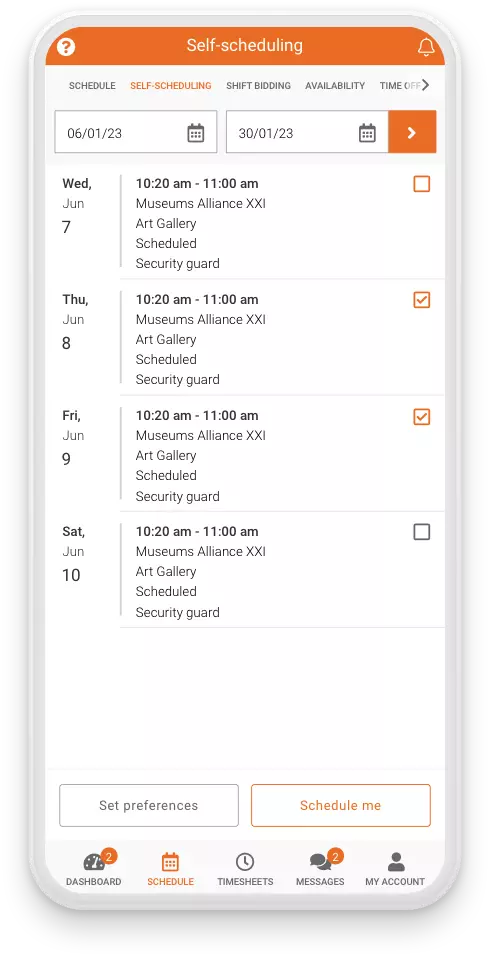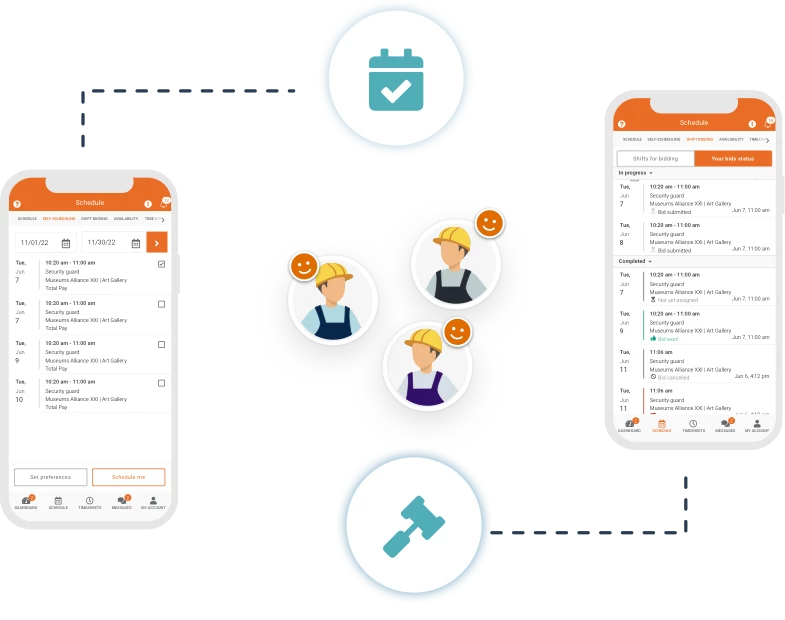Flexible scheduling is not a new concept. However, in the last couple of years, more and more companies are looking for ways to improve flexibility. Whether it’s where employees work from or when they work, employers know that flexibility is essential.
83% of workers in the U.S. think flexible working hours are important. About 74% also value the ability to work from different locations.
Workmonitor
Over the last 3-4 years, workplaces have been re-examining how they view workforce management. They have been focusing on how to keep operations running in the face of change. Employees have also realized the potential for work-life balance, and how easy that can be achieved given the right support.
What is Flexible Scheduling?

Flexible scheduling is an alternative to the traditional working environment, providing employees with flexibility. While the degree of flexibility may differ, it allows employees to create a work-life routine that suits them. Flexible scheduling takes responsibility away from the employer while allowing them to maintain control.
Most employers are hesitant to introduce flexible scheduling due to a lack of understanding. They fear the idea of not having control, and of course, they worry that the business will suffer. In reality, there is a range of benefits to flexible scheduling for both the employee and the employer! When handled effectively, all worries can easily be mitigated.
Benefits of Flexible Scheduling
For the employees
Companies have time and again resorted to various wellness programs for employees, and they have largely been successful. From providing assistance in the form of yoga classes and healthy snacks, companies have brought aspects of fun and relaxation to the workplace. However, the introduction of flex schedules provides employees with way more than other fringe benefits, and provides higher levels of employee satisfaction. Here is a list of benefits of flexible scheduling for the employees:
- Elevate morale: Consumers search for convenience whenever they are purchasing something. Likewise, employees too look for convenience as a measure to build productivity. Employees would rather have their work arrangement be flexible than be filled with employers that are micromanaging. With flexible scheduling, an employee might feel more confident and enthusiastic about working and consequently become more productive.
- Better work-life balance: Finding the optimal work-life balance may seem impossible, but flexible scheduling is a huge step in the right direction. How so? If you have read any of our blogs about absenteeism or no-shows in the workplace, you would be familiar with why work-life balance is the key solution to minimize employee turnover.
Offering remote work, flexplace, or flextime lets employees set their own schedules. This helps them save time on commuting. As a result, they can focus more on personal life outside of work.
For the employers
Flexible Scheduling is beneficial for the employers and the company too. This may surprise some, so let us explain in detail why employers that do not provide flexible scheduling are really missing out!

- Attract and retain top talent: Employers get tired of having employee turnover, and naturally, morale plays a role here. If your company seeks to attract a pool of diverse talents for your company, you must offer them a chance to be happy. Morale and a work-life balance play a key role in employee productivity. By using flexible scheduling, companies can metaphorically flex their muscles and attract the best talent available.
- Reduce burnout and increase productivity: By letting employees contribute to the scheduling process, they are much less likely to suffer from burnout. This is a huge issue in industries such as home healthcare, security & manufacturing. By reducing the liklihood of burnout, employers can relax and trust that their workforce is performing at the optimum level.
An employee-driven work culture also gives employers the ability to take a foot off the pedal and reduce the chance of their burnout too. A highly productive and motivated workforce eases the burden on the employer to push and inspire and can reduce the chance of burnout. After all, micromanaging can be tedious and vexing for employers, too, not just the employees.
How to Introduce Flexible Scheduling
Transitioning to a flexible scheduling system can be laborious and requires a well-communicated strategy with the entire workforce. Creating a blueprint of this plan is tedious, and there might be specific issues that arise, but under the proper guidance, these problems can be minimalized. Thankfully, with automated employee scheduling software, flexible work schedules can be implemented with ease. Here are some key takeaways and strategies that any employer must remember to employ when implementing flexible scheduling:
Create a flexible working policy:

Whether digital or handwritten, a document must be made and distributed to the entire workforce discussing how the business will approach flexible working. The policies should be in alignment with business expectations and should guide employees to the right path. These policies vary business-to-business, and the fundamentals of a flexible working policy are to identify the initial challenges that can occur and find adaptive solutions.
Educate employees about the new scheduling system:
Once a foundation is made in the form of an official document, it’s imminent that the employees understand it clearly. Educating employees is important because employees can benefit from it only when they understand what flexible Scheduling allows and disallows. Without the proper education and training on these new systems, employers may start to abuse them, or worse, ignore them altogether.
Train managers and schedulers with the entire process:
The key part of transitioning to the new system is understanding the process. Most business transitions have various potholes that can create issues. Managers and schedulers are key here to fix these potholes and create a clear path for the entire workforce. In order for flexible scheduling to be successful, managers must be on board and aware of the changes to the scheduling process.
Communicate with your employees from DAY 1:
When you are considering introducing flexible scheduling, it is vital to involve employees. Work with them to determine what needs/wants they have. Reassure them if they have any worries or concerns. Allow them to voice their opinions and have their voice heard.
By involving employees from the start, it increases the likelihood of a smooth transition to new processes and systems.
Pro tip: Rather than monitoring and measuring employees based on hours worked, measure on the basis of output. Employers often get wrapped up in how many hours an employee works. This is not always an accurate portrayal of how much work they actually do.
When you introduce flexible scheduling, try to refrain from looking at employees in this way. This will change the way both you, and your employees look at the schedule.
Types of Flexible Scheduling
Flexible scheduling comes in many different formats. Employers can utilize one, some, or all of these methods to achieve their desired level of flexibility. Celayix employee scheduling software can help you implement these methods with ease.
Employee Availability
A little nervous about introducing flexible Scheduling as an employer? Well, you could start by just asking employees to input their availability for any shifts. By knowing your employee’s availability and unavailability, the company is on the right track in transitioning towards flexible Scheduling. Celayix’s scheduling software provides this feature so that the scheduler never makes an error of giving a shift to an employee that is unable to make the shift.
Self-Scheduling:

Self-Scheduling is another clever feature where employers keep some open shifts available to all qualified employees. On the basis of first-come-first-served, the employee can claim the shift as per their liking. You really must be wondering right now; Flexible Scheduling is so simple yet so clever, right?
Shift-bidding:
Shift bidding is a process whereby one or more employees can express interest in working an open shift in the form of a “bid”. It is an automated alternative method to Scheduling that allows the scheduler to retain total control while also giving employees more autonomy over their schedule.
However, Employees will only be able to see the shifts they qualify for. After receiving a notification, employees can select which shift they would like to work and submit their interest in the form of a “bid”. Shift bidding is similar to self-scheduling; however, it is not managed first come-first served. Instead, schedulers can review the employees that have expressed interest and make their own decisions from there.
Compressed Work Weeks:
Compressed work weeks is a unique type of flexible scheduling where the employee has an unequal distribution of hours in fewer days. This generally would mean working more hours within a period of time. The concept of 4-day work weeks has been a hot topic for some time now. This type of scheduling comes with various advantages, such as allowing employees to get extra days off for personal time and reduce their commuting costs. Moreover, an employer might allow an employee to work anytime they want as long as they remain productive over the required number of hours.
Remote-working:
Working remote obviously became the norm for many from 2020 onwards. We learned that certain employees can perform tasks entirely away from the office through remote-working, whether temporarily or permanently. With physical location now insignificant, team members can seek employees from all around the world and improve the quality of their workforce.
However, within the solution lies a small problem. Remote-working is not possible for all industries. Some industries require the presence of staff at the workplace, and that certainly reduces options. So, for industries like hospitality, security, healthcare etc. flexible working hours are often ore suited.
Moreover, these systems rely on effective communication through video conferencing mediums. This may not be a viable option for many industries either. Learning how to manage remote or mobile workforces requires a bit of effort, but it surely can later help save a lot of time, energy and money!
So what should you do?

Don’t over-commit yourself and end up souring a good relationship with your employees. Most companies start by offering flexible schedules as a trial period with sound evaluation on both managers and employees. What may work best is offering flexible start and end times or workdays worked, or perhaps just one or two days of flextime per week.
When evaluating flextime requests, consider your current corporate culture—making changes to where and when work is performed, and your level of flexibility may impact the worker and manager and the organization as a whole.
As leaders in workforce management, we’ve helped employers provide flexible schedules to their employees for over a decade. If you’re interested in hearing more about how we can help you do the same, check out a free live, custom demo here!




